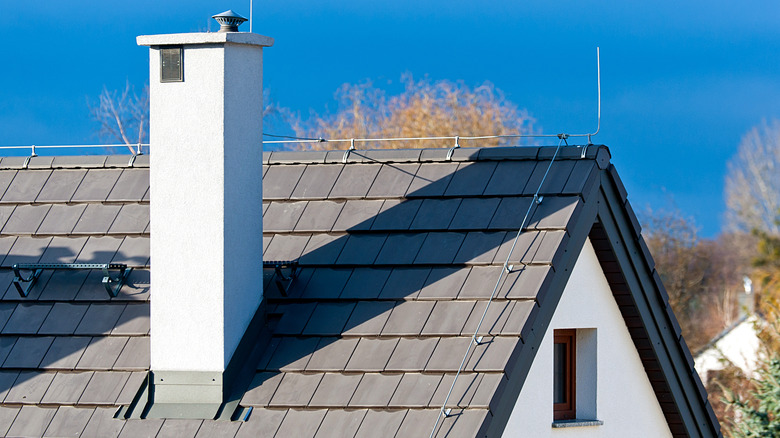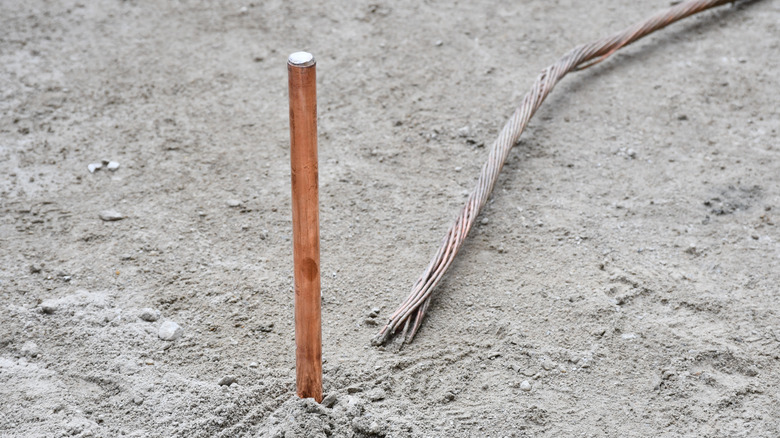Do You Need A Lightning Rod To Protect Your Home?
Ever since Benjamin Franklin's famous kite experiment showed that lightning could be attracted to metal structures, people have wondered how to protect themselves and their homes from it. In typical fashion, Franklin imagined the solution himself: The Franklin Institute explains that he fashioned a pointed iron rod to intercept a lightning bolt before it could strike. Nearly 400 years later, modern lightning rods work on the same principle. They are designed to provide a safe path for lightning to disperse and neutralize in the ground, thus averting harm to the structure and its occupants.
However, the question remains, is a lightning rod actually necessary for your home? According to ValChoice, 40 million annual U.S. lightning strikes result in up to 200,000 insurance claims to the tune of $1 billion. Moreover, there are close to 25,000 lightning-related fires per year. While a lightning rod neither attracts nor repels a strike, its ability to divert a bolt away from the house and into the ground is a potential lifesaver. As noted by Mr. Electric, this protective device is especially recommended if the building is tall, or is the highest in the area; if nearby trees are within 10 feet of the home; or if you are situated in a high-strike area, such as Florida, Georgia, and Texas. The Lightning Rod Man adds that a lightning protection system is one of the most reliable defenses against fire.
Lightning rod options
Per HomeAdvisor, there are two types of lightning rods. The Franklin rod — usually made of highly conductive copper or aluminum wire — is the most common, and is sometimes referred to as a strike termination device. There is also a more expensive and elaborate system, known as an air terminal, that works by emitting ionized particles. Depending on a home's size and the number of levels, multiple rods installed at various intervals may be needed. Standard, decorative, or antique styles are available. A complete safety set-up including ground rods, lightning arresters, and surge protectors is another choice.
A tree protection system can add another layer of defense to your home's lightning rod. According to Advanced Tree Care, a copper cable should be extended along the tree from as near to the top as possible. It is then buried and directed out to a grounding rod. This is an effective precaution, as branches from trees struck by lightning can damage structures, the bolt can ricochet into a house, and lightning can even penetrate a home through the tree roots.
Further, electrical appliances and other advances in technology have made today's homes more vulnerable to lightning, and therefore more in need of a rod than ever before. Nickle Electrical Company points out that lightning, on its way to the ground, might jump to cables, power lines, computers, and other devices inside the house.
Not a DIY project
A home's lightning rod or complete safety system should be set up and installed by a pro, urges Designing Idea, because an improper design could be more harmful than none at all. Doing it yourself may also add to the cost. A specialist will determine how many, and where the rod or rods should be placed for maximum effectiveness.
Should one decide to embark on a DIY project, all the components will have to be purchased separately, possibly including the rods, mounts, fasteners, conductors, and surge protectors. Obviously, the lightning protection would have to be correctly and safely erected, and should ideally meet the safety requirements of NFPA Standard 780. A lightning specialist likely would provide a package deal and install the system correctly, giving you peace of mind. In addition, insurance companies agree a lightning rod is a necessary safety feature and many homeowners' policies offer the applicable insurance credits.


